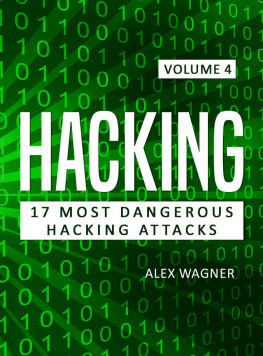Alan T. Norman - Hacking: Computer Hacking Beginners Guide How to Hack Wireless Network, Basic Security and Penetration Testing, Kali Linux, Your First Hack
Here you can read online Alan T. Norman - Hacking: Computer Hacking Beginners Guide How to Hack Wireless Network, Basic Security and Penetration Testing, Kali Linux, Your First Hack full text of the book (entire story) in english for free. Download pdf and epub, get meaning, cover and reviews about this ebook. year: 2016, genre: Computer. Description of the work, (preface) as well as reviews are available. Best literature library LitArk.com created for fans of good reading and offers a wide selection of genres:
Romance novel
Science fiction
Adventure
Detective
Science
History
Home and family
Prose
Art
Politics
Computer
Non-fiction
Religion
Business
Children
Humor
Choose a favorite category and find really read worthwhile books. Enjoy immersion in the world of imagination, feel the emotions of the characters or learn something new for yourself, make an fascinating discovery.
- Book:Hacking: Computer Hacking Beginners Guide How to Hack Wireless Network, Basic Security and Penetration Testing, Kali Linux, Your First Hack
- Author:
- Genre:
- Year:2016
- Rating:5 / 5
- Favourites:Add to favourites
- Your mark:
- 100
- 1
- 2
- 3
- 4
- 5
Hacking: Computer Hacking Beginners Guide How to Hack Wireless Network, Basic Security and Penetration Testing, Kali Linux, Your First Hack: summary, description and annotation
We offer to read an annotation, description, summary or preface (depends on what the author of the book "Hacking: Computer Hacking Beginners Guide How to Hack Wireless Network, Basic Security and Penetration Testing, Kali Linux, Your First Hack" wrote himself). If you haven't found the necessary information about the book — write in the comments, we will try to find it.
Alan T. Norman: author's other books
Who wrote Hacking: Computer Hacking Beginners Guide How to Hack Wireless Network, Basic Security and Penetration Testing, Kali Linux, Your First Hack? Find out the surname, the name of the author of the book and a list of all author's works by series.
Hacking: Computer Hacking Beginners Guide How to Hack Wireless Network, Basic Security and Penetration Testing, Kali Linux, Your First Hack — read online for free the complete book (whole text) full work
Below is the text of the book, divided by pages. System saving the place of the last page read, allows you to conveniently read the book "Hacking: Computer Hacking Beginners Guide How to Hack Wireless Network, Basic Security and Penetration Testing, Kali Linux, Your First Hack" online for free, without having to search again every time where you left off. Put a bookmark, and you can go to the page where you finished reading at any time.
Font size:
Interval:
Bookmark:
Hacking
Computer Hacking Beginners Guide How to Hack Wireless Network, Basic Security and Penetration Testing, Kali Linux, Your First Hack
ALAN T. NORMAN
Copyright All Right Reserved.
No part of this publication may be reproduced, distributed, or transmitted in any form or by any means, including photocopying, recording, or other electronic or mechanical methods, or by any information storage and retrieval system without the prior written permission of the publisher, except in the case of very brief quotations embodied in critical reviews and certain other noncommercial uses permitted by copyright law.
Disclaimer Notice:
Please not the information contained within this document is for educational and entertainment purposes only. Every attempt has been made to provide accurate, up to date and reliable complete information. No warranties of any kind are expressed or implied.
By reading this document, the reader agrees that under no circumstances are is the author responsible for any losses, direct or indirect, which are incurred as a result of the issue of information contained within this document, including, but not limited to errors, omissions, or inaccuracies.
Like any other technological advancement in human history, the benefits gained by mankind from the computerization and digitization of our world come at a price. The more information we can store and transmit, the more it becomes vulnerable to theft or destruction. The more dependent our lives become on technology and on rapid, instantaneous communication, the greater are the consequences of losing access to those capabilities. It is not only possible, but in fact routine for billions of dollars to be transferred overseas in the blink of an eye. Entire libraries can be stored on devices no bigger than a human thumb. It is common to see toddlers playing rather mundane games on smartphones or tablets that have more computing power than machines which just 50 years ago would have filled entire rooms.
This unprecedented concentration of data and digital wealth, coupled with societys increasing reliance on digital means of storage and communication, has been a bonanza for savvy and malicious opportunists eager to take advantage of every vulnerability. From individuals committing petty theft and fraud, to political activists, large and highly organized criminal cabals, terrorist groups, and nation-state actors, computer hacking has become a multi-billion dollar global industry - not only in the commission of the crimes themselves, but in the time, effort and capital dedicated to protecting information and resources. It is impossible to exaggerate the implications of computer security in our current time. The critical infrastructure of cities and entire nations is inextricably tied to computer networks. Records of daily financial transactions are digitally stored whose theft or deletion could wreak havoc on entire economies. Sensitive email communications can sway political elections or court cases when released to the public. Perhaps the most concerning of all potential vulnerabilities is in the military realm, where increasingly networked and computerized instruments of war must be kept out of the wrong hands at all cost. These high-profile threats are accompanied by the lesser, but cumulative effects of smaller scale transgressions like identity theft and leaks of personal information that have devastating consequences to the lives of everyday people.
Not all hackers have necessarily malicious intent. In nations with hampered freedom of speech or oppressive laws, hackers serve to spread vital information among the populace that might normally be suppressed or sanitized by an authoritarian regime. Although their activity is still illegal by their own countrys laws, many are considered to be serving a moral purpose. Ethical lines are therefore often blurred when it comes to hacking for the purpose of political activism or for the dissemination of information that could be of value to the public or to oppressed populations. In order to limit the damage that can be done by individuals and groups with less-than-honorable intentions, it is necessary to keep up with the tools, procedures and mindsets of hackers. Computer hackers are highly intelligent, resourceful, adaptive and extremely persistent. The best among them have always been, and will likely continue to be, a step ahead of efforts to thwart them. Thus, computer security specialists endeavor to become just as adept and practiced at the art of hacking as their criminal adversaries. In the process of gaining this knowledge, the ethical hacker is expected to make a commitment not to use their acquired skills for illegal or immoral purposes.
This book is intended to serve as an introduction to the language, landscape, tools, and procedures of computer hacking. As a beginners guide, it assumes that the reader has little prior knowledge of computer hacking per se, other than what they have been exposed to in media or casual conversation. It does assume a general laypersons familiarity with modern computer terminology and the internet. Detailed instructions and specific hacking procedures are out of the scope of this book and are left for the reader to pursue further as they are more comfortable with the material.
The book begins in Chapter 1: What is Hacking? with some basic definitions so that the reader can become familiar with some of the language and jargon used in the realms of hacking and computer security, as well as to clear up any ambiguities in terminology. Chapter 1 also distinguishes the different types of hackers with regard to their ethical and legal intentions and the ramifications of their activities.
In Chapter 2: Vulnerabilities and Exploits, the central concept of target vulnerability is introduced, describing the the main vulnerability categories and some specific examples. This leads into a discussion of how hackers take advantage of vulnerabilities through the practice of exploitation.
Chapter 3: Getting Started walks through the many subjects and skills with which a beginning hacker needs to become familiar. From computer and network hardware, to communication protocols, to computer programming languages, the chief topical areas of a hackers knowledge base are outlined.
Chapter 4: The Hackers Toolkit delves into the common hardware, software, operating systems, and programming languages generally preferred by hackers to ply their trade.
The general procedures for some common computer attacks are surveyed in Chapter 5: Gaining Access, providing some select examples of attacks that are often of interest to hackers and computer security professionals.
Chapter 6: Malicious Activity and Code reveals some of the more nefarious attacks and constructs of hackers who aim to cause harm. The differences between the different categories of malicious code are explained.
Chapter 7: Wireless Hacking focuses specifically on the exploitation of vulnerabilities in Wi-Fi network encryption protocals. The specific hardware and software tools needed to execute simple Wi-Fi attacks are listed.
The reader is given some practical guidance on setting up and practicing some beginner-level hacking in Chapter 8: Your First Hack. Two exercises are selected to help the aspiring hacker get their feet wet with some simple tools and inexpensive equipment.
Chapter 9: Defensive Security & Hacker Ethics wraps up this introduction to hacking with some notes about protecting oneself from hackers, and discusses some of the philosophical issues associated with the ethics of hacking.
It is important to lay the groundwork for a proper introduction to computer hacking by first discussing some commonly used terms and to clear up any ambiguities with regard to their meanings. Computer professionals and serious hobbyists tend to use a lot of jargon that has evolved over the years in what had traditionally been a very closed and exclusive clique. It isnt always clear what certain terms mean without an understanding of the context in which they developed. Although by no means a complete lexicon, this chapter introduces some of the basic language used among hackers and computer security professionals. Other terms will appear in later chapters within the appropriate topics. None of these definitions are in any way official, but rather represent an understanding of their common usage.
Font size:
Interval:
Bookmark:
Similar books «Hacking: Computer Hacking Beginners Guide How to Hack Wireless Network, Basic Security and Penetration Testing, Kali Linux, Your First Hack»
Look at similar books to Hacking: Computer Hacking Beginners Guide How to Hack Wireless Network, Basic Security and Penetration Testing, Kali Linux, Your First Hack. We have selected literature similar in name and meaning in the hope of providing readers with more options to find new, interesting, not yet read works.
Discussion, reviews of the book Hacking: Computer Hacking Beginners Guide How to Hack Wireless Network, Basic Security and Penetration Testing, Kali Linux, Your First Hack and just readers' own opinions. Leave your comments, write what you think about the work, its meaning or the main characters. Specify what exactly you liked and what you didn't like, and why you think so.











